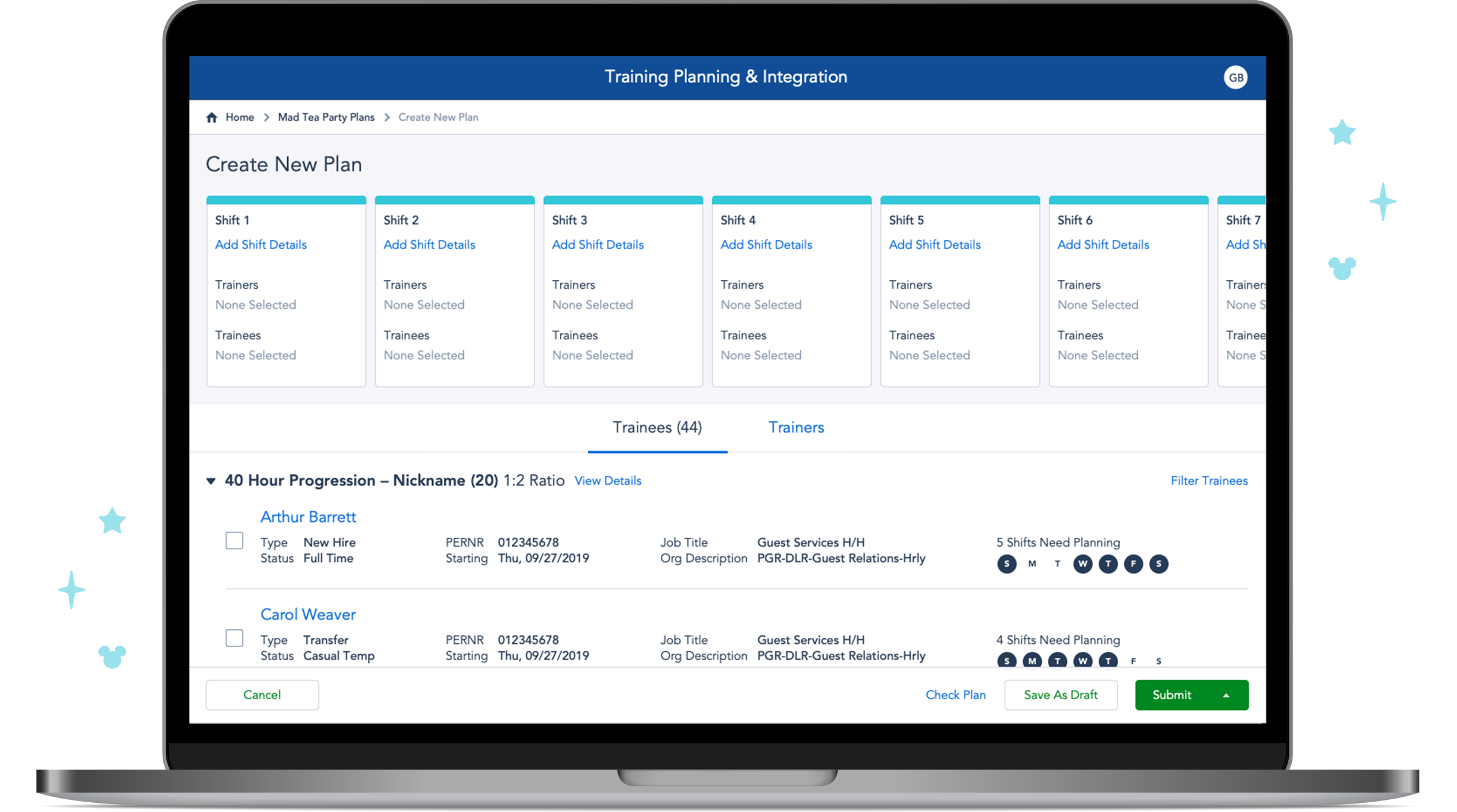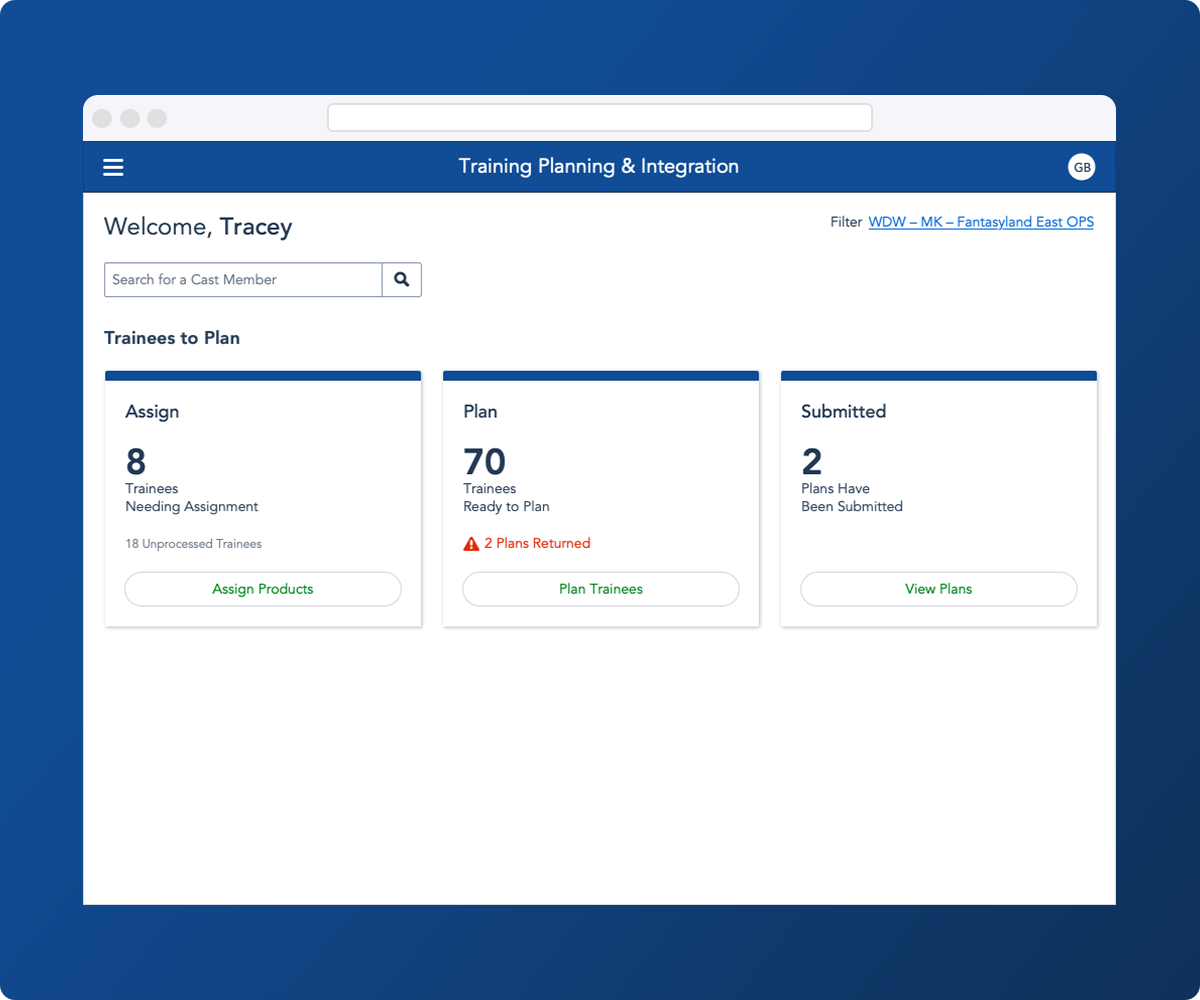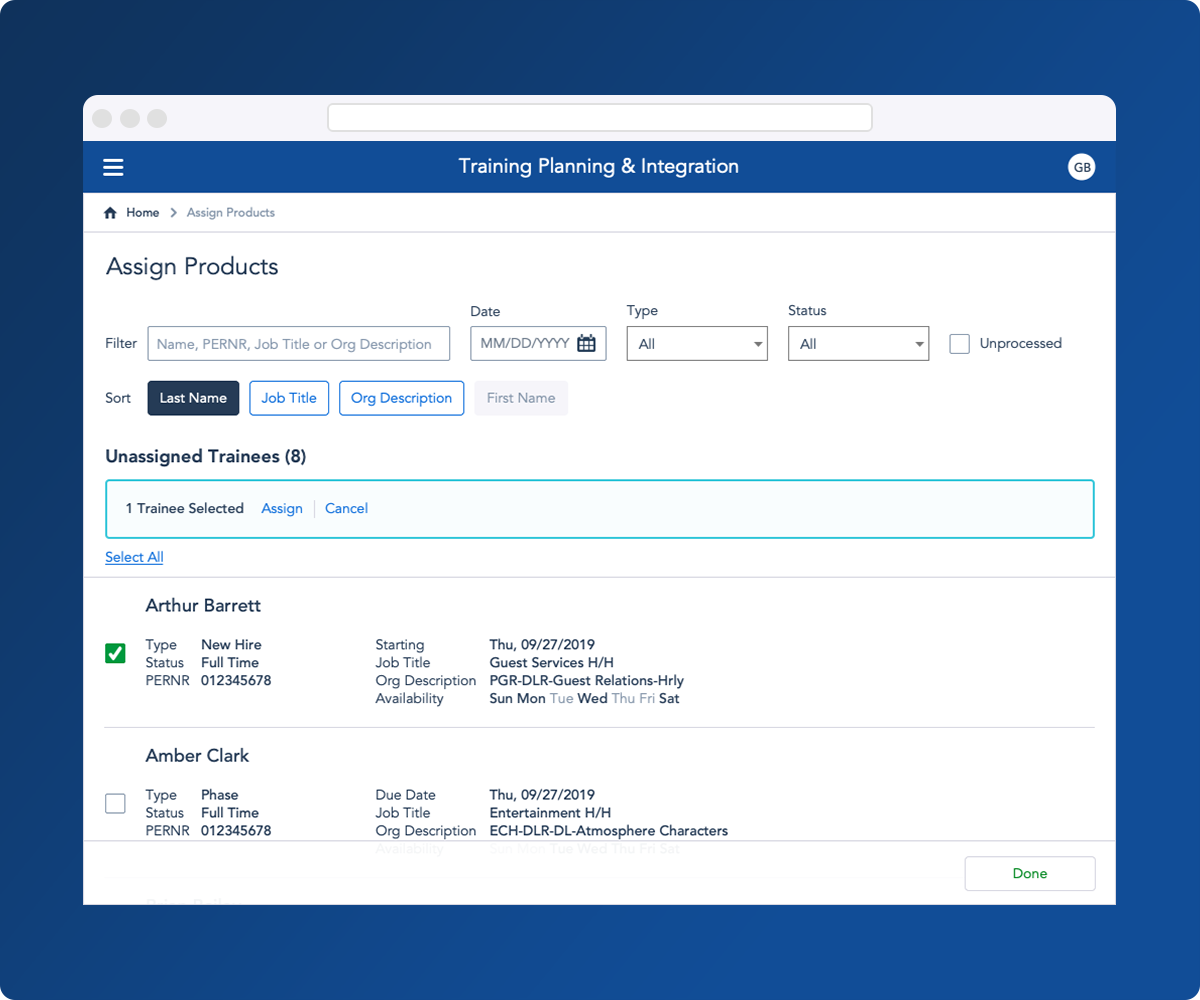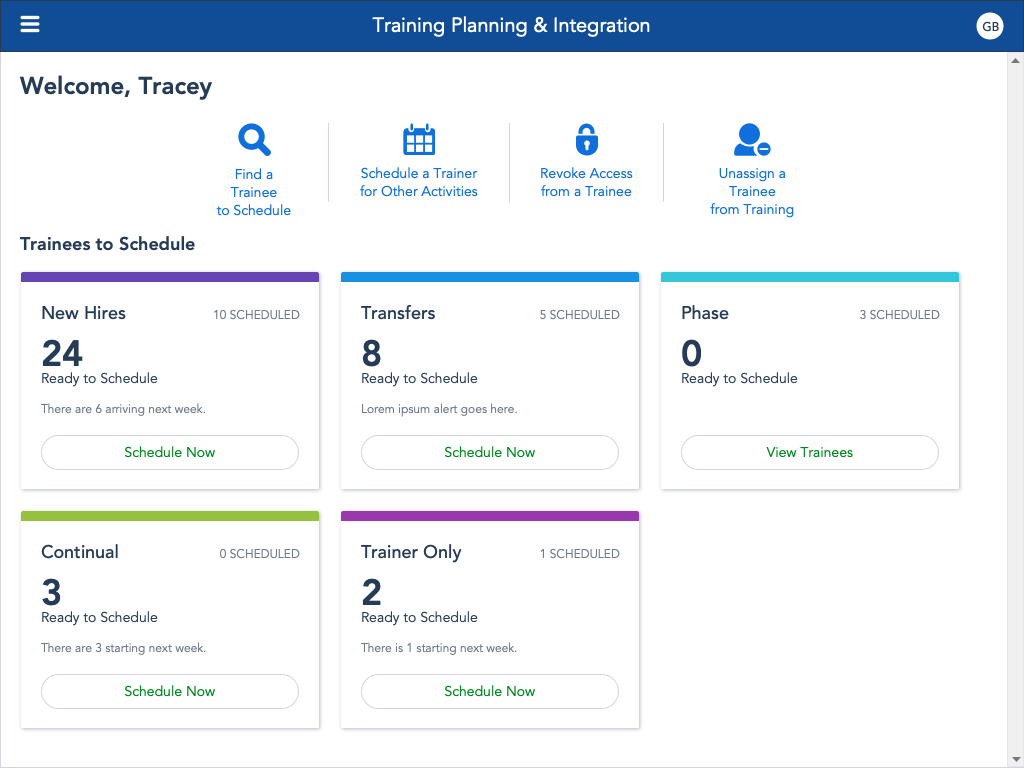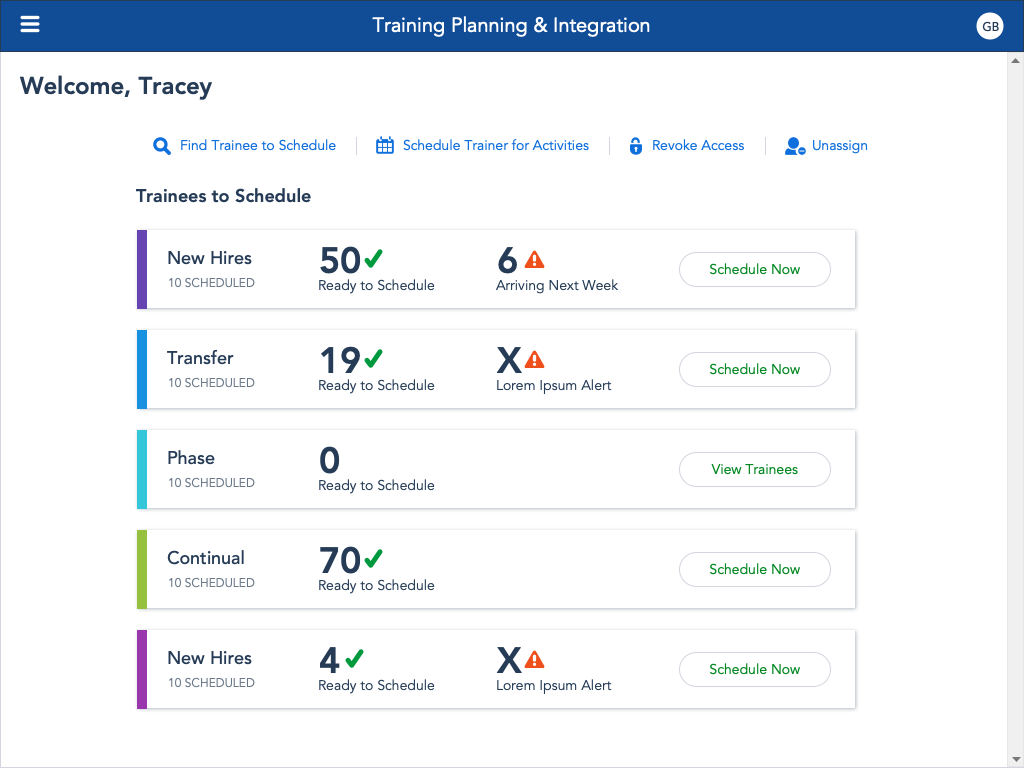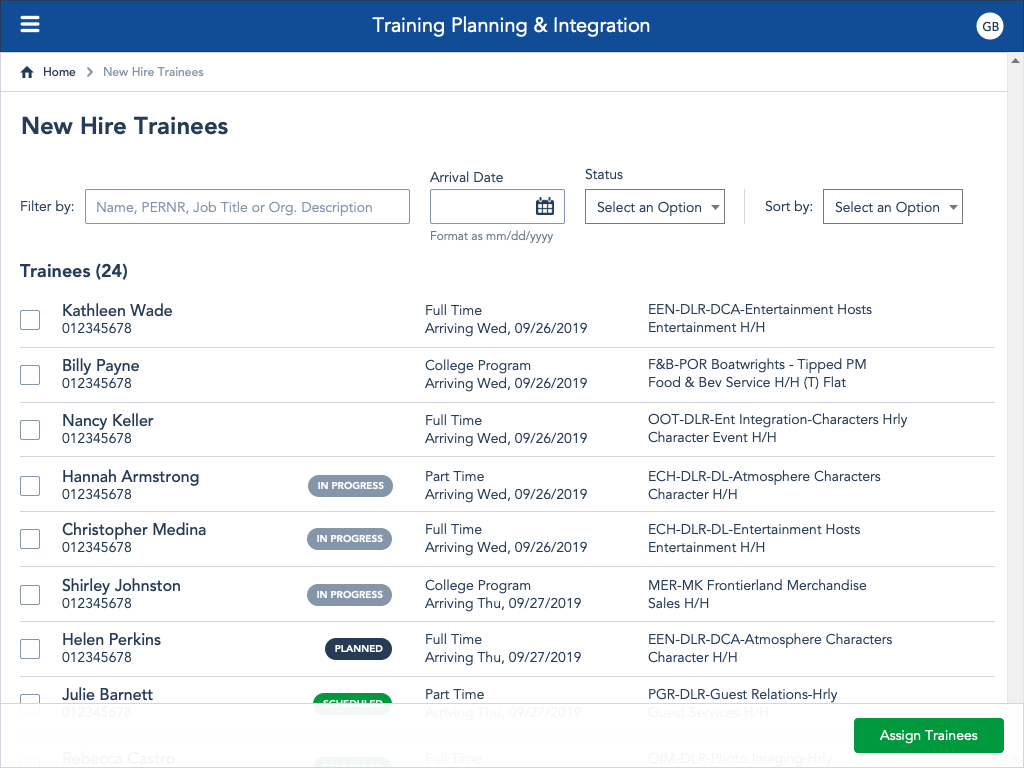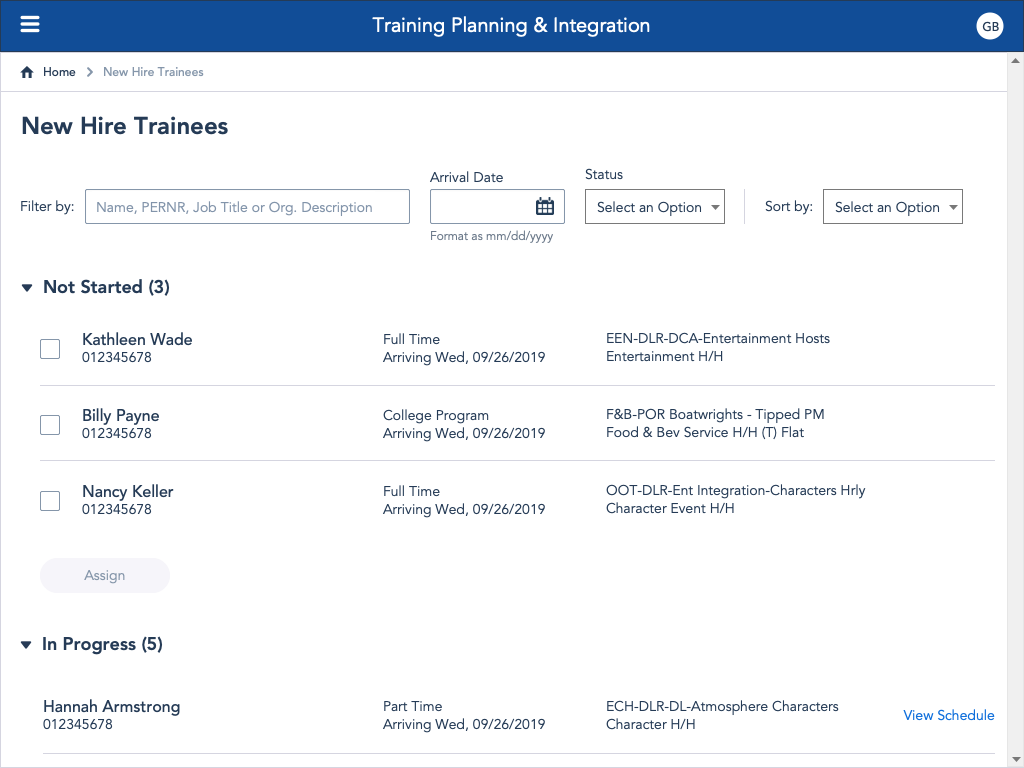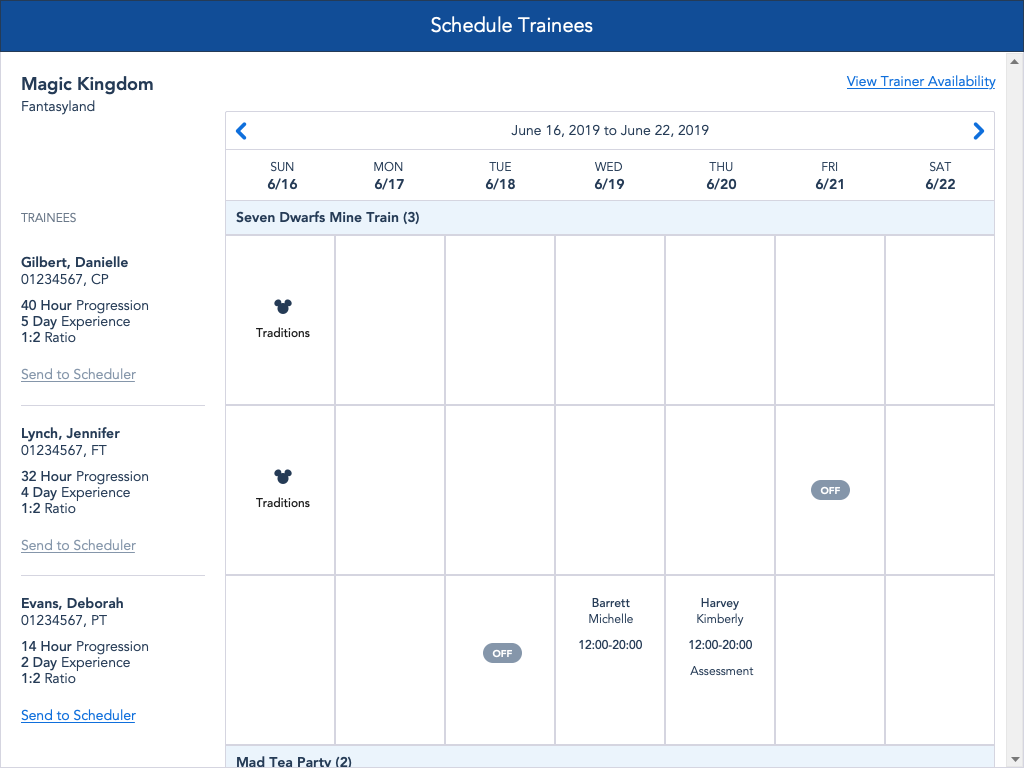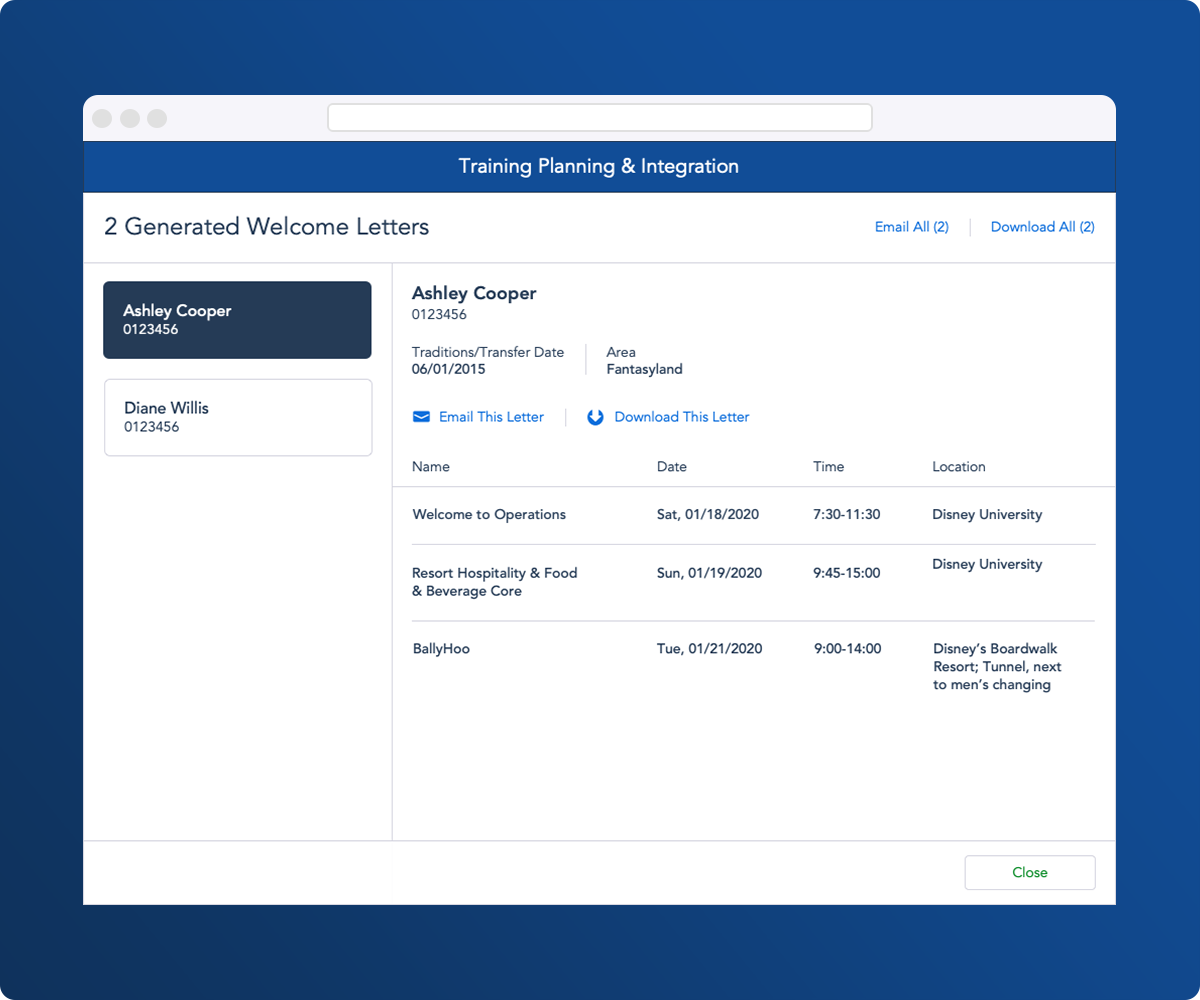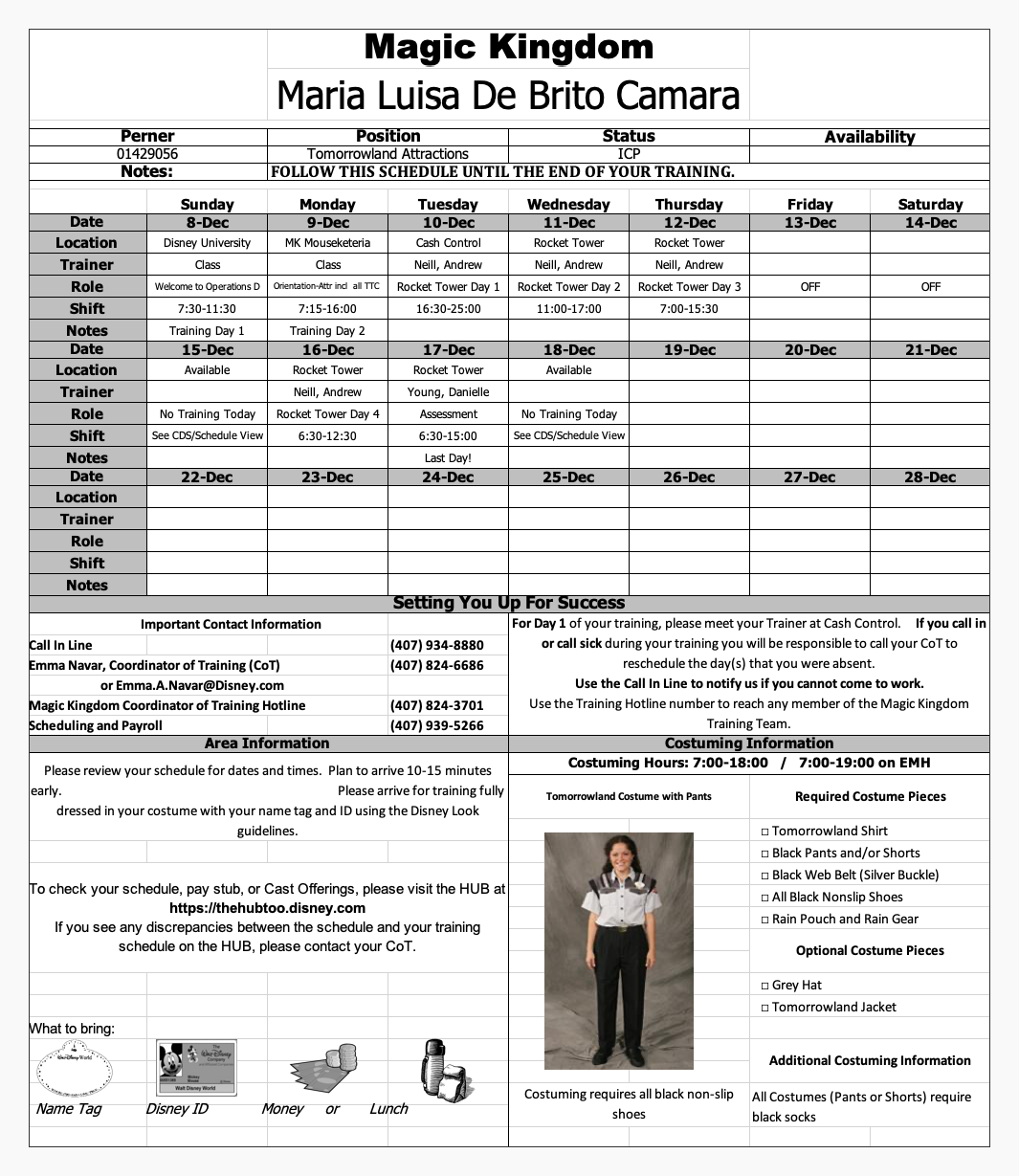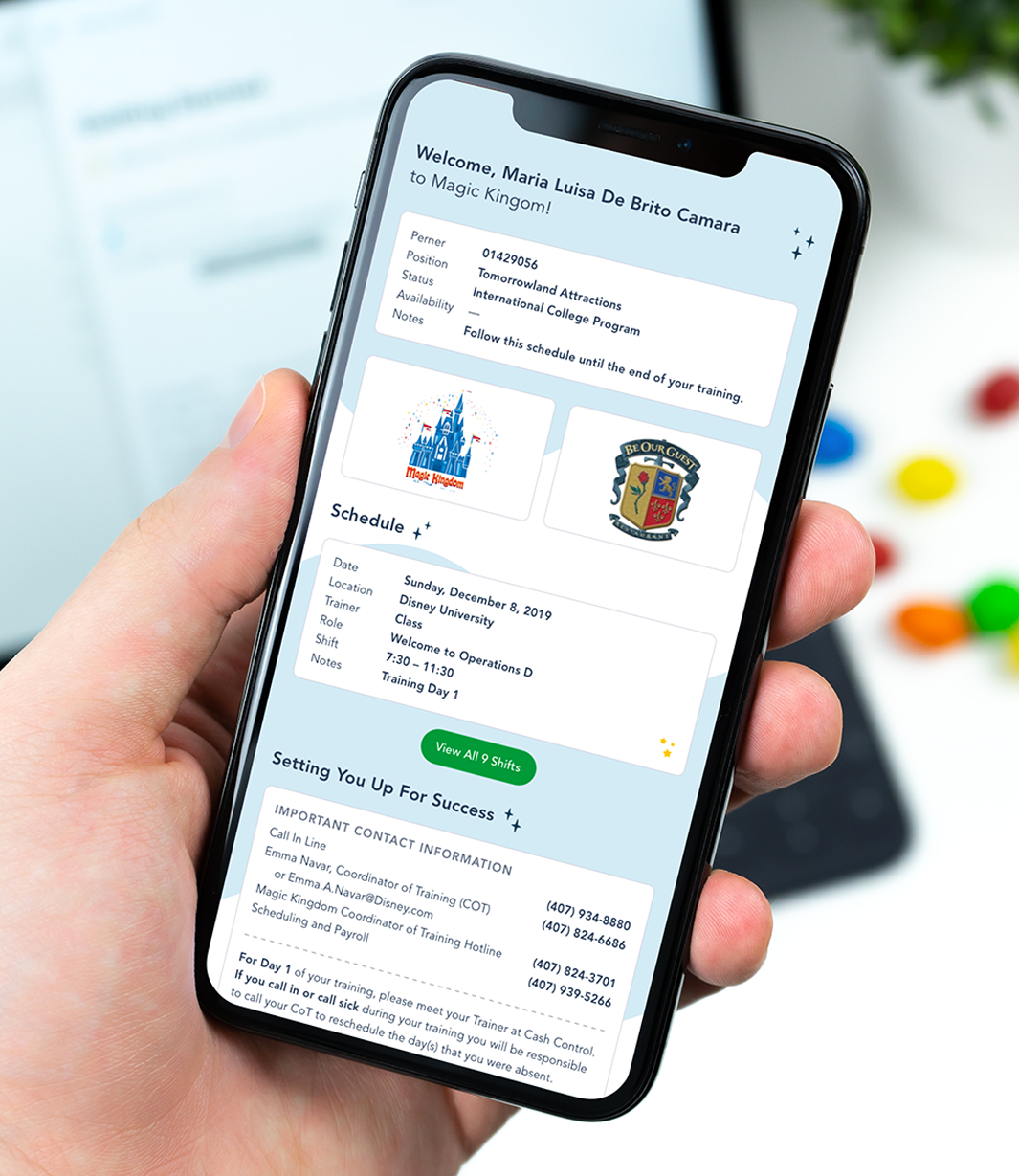DESKTOP WEB APP CASE STUDY
Walt Disney World's
Training Planning Application
OVERVIEW
The Walt Disney World training team needed to revamp their approach to assigning, planning, and scheduling employee training.
The existing training planning process hadn't been updated in over three decades. With more than 500 Cast Members involved, much of the work depended on manual, paper-based methods. I partnered with Disney’s Training Innovation team to develop an application that enables Cast Members to assign training and schedule employees, ultimately replacing the outdated Excel-based system that had been in use for over 30 years.
ROLE & DETAILS
Lead Product Designer
User Research, Personas, Empathy Maps, Sketchboarding, Wireframing, Prototyping, User Testing, Documentation, Visual QA
Team
1 Product Designer, 3 Product Owners,
1 Business Analyst, 7 Engineers
Timeline
August 2018 – February 2020
THE CHALLENGE
"How might we design a flexible application that empowers our 500+ users to assign, plan, and schedule training in any sequence they choose?"
The opportunity to completely reinvent how Cast Members assign, plan, and schedule training was exciting—but it came with considerable challenges. For over 30 years, more than 500 users had relied on Microsoft Excel, email, and verbal communication, each following their own unique approach. While a standardized user flow promised benefits like streamlined processes and fewer edge cases, the business team valued flexibility, wanting users to complete tasks in the way that worked best for them. Consequently, the application had to be both intuitive and adaptable enough to support the diverse workflows of all users.
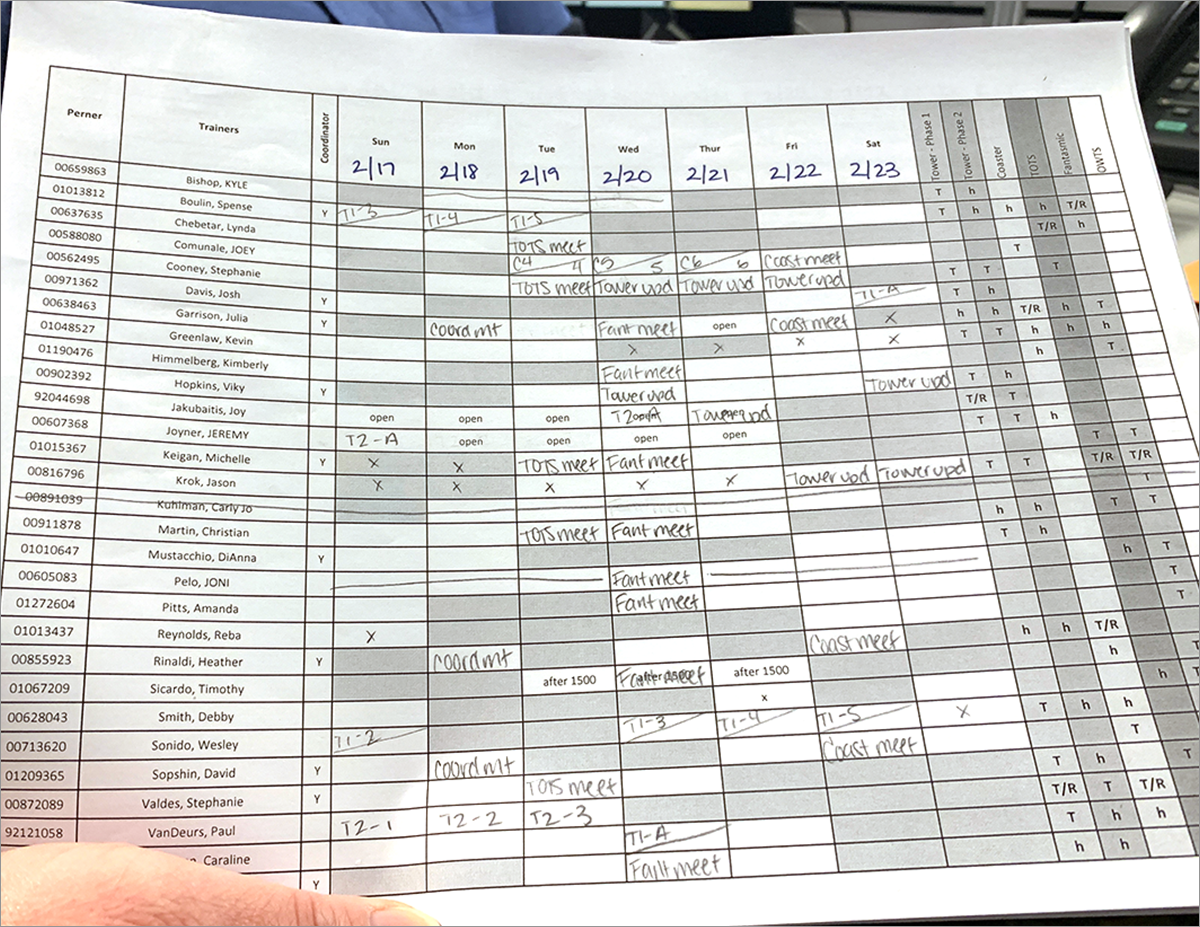
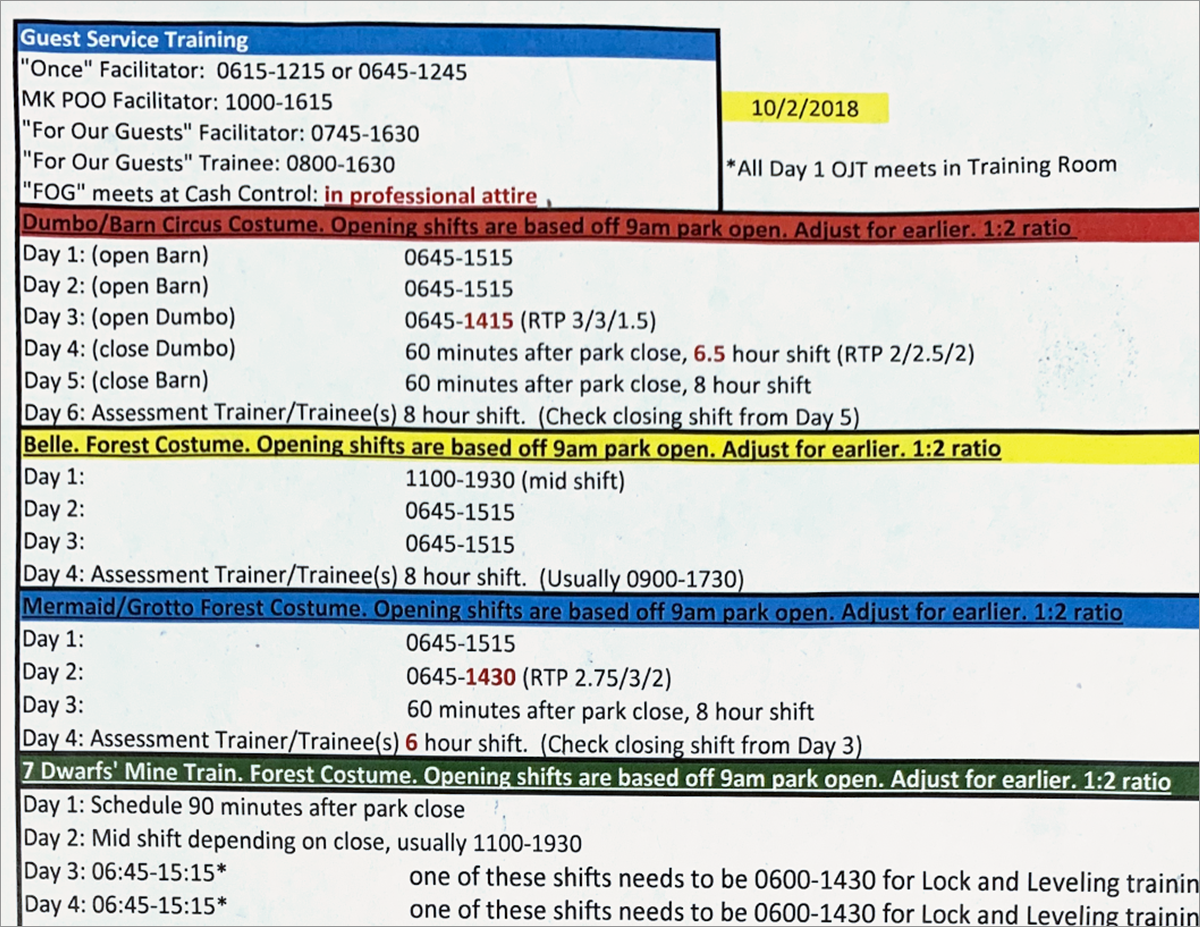
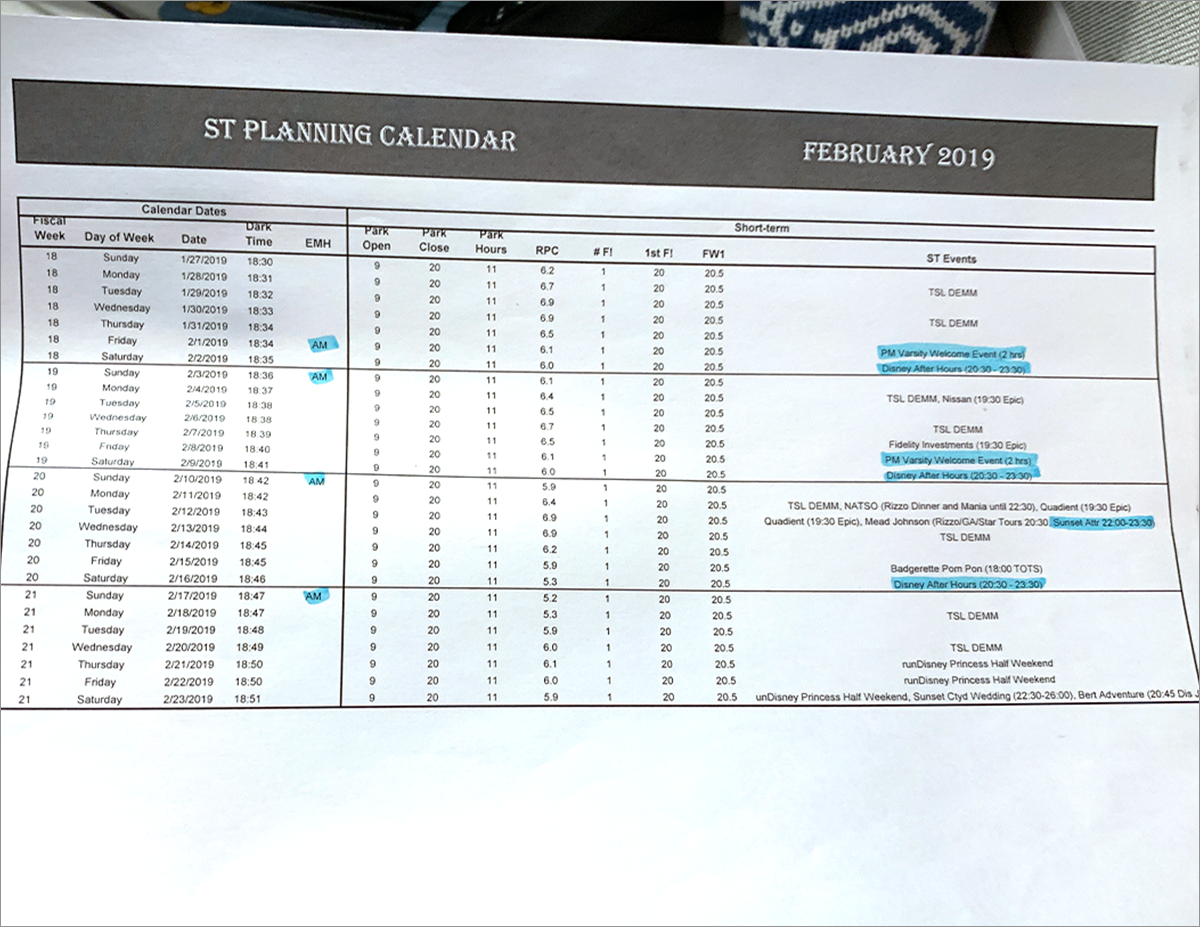
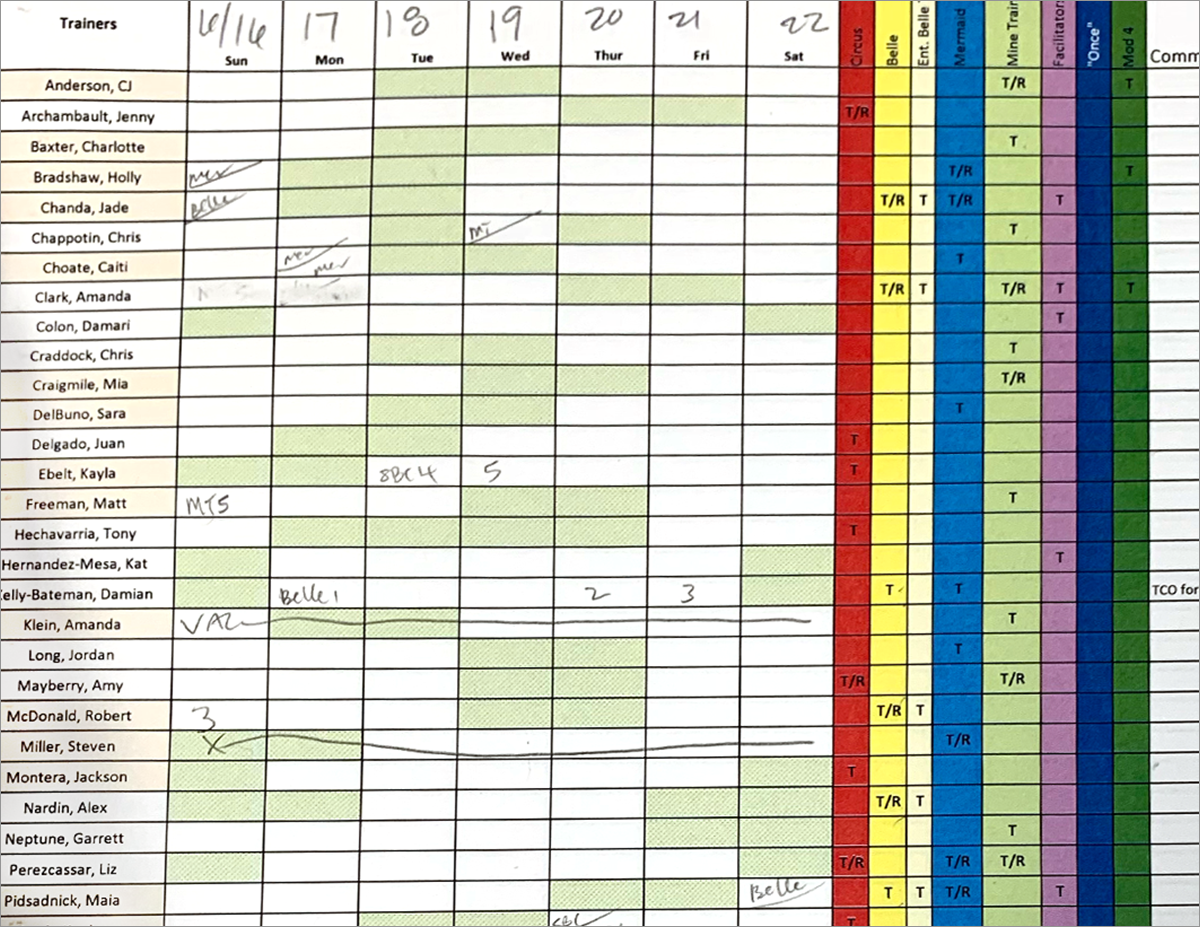
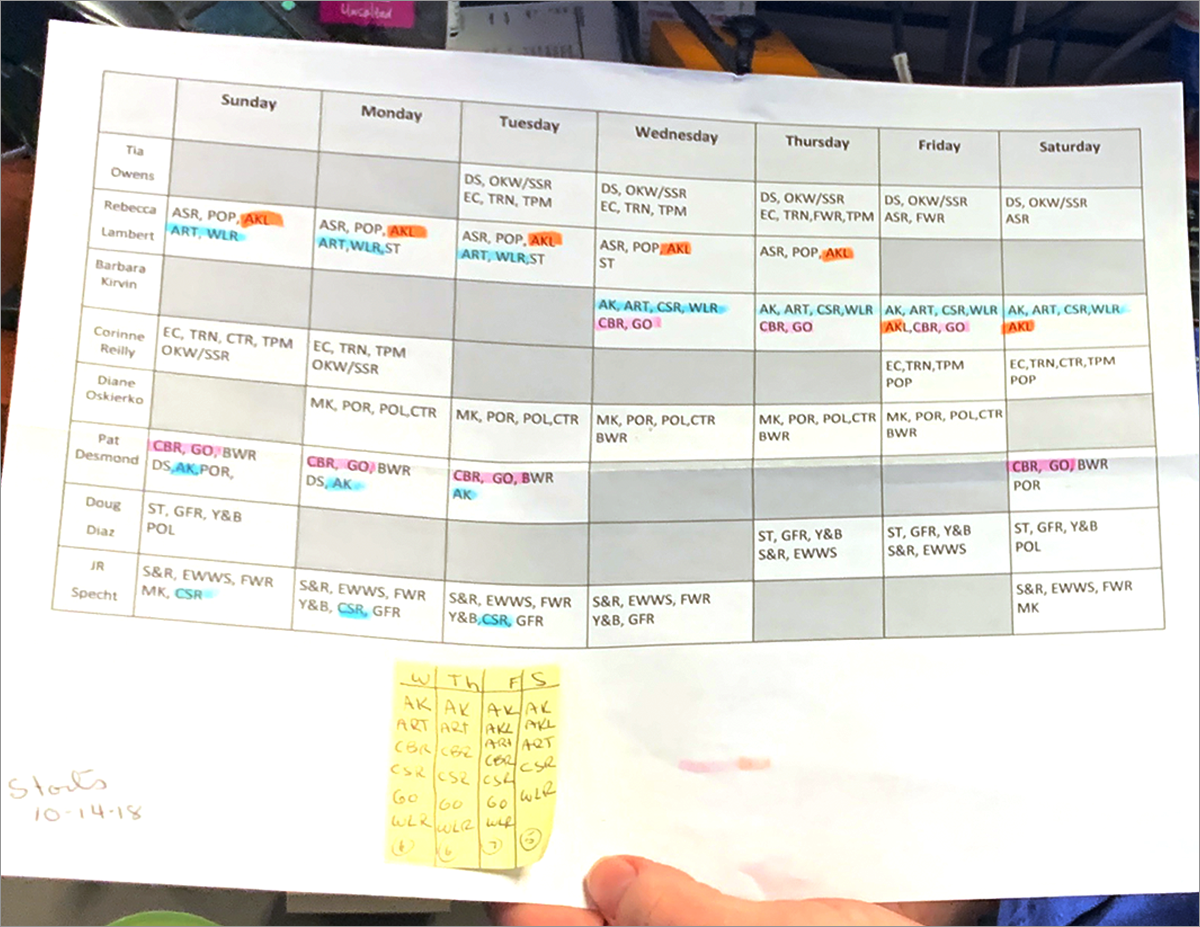
USER RESEARCH
I began by engaging with users to learn more about how they work.
By interviewing users and shadowing their daily tasks, I was able to truly step into their shoes and develop a deep empathy for their challenges. Without this firsthand experience, I wouldn’t have fully appreciated the sheer volume of paper each Cast Member handled or the significant time spent managing it. It quickly became clear that the new application needed to minimize paper usage, cut costs, boost operational efficiency, and promote environmental sustainability.
PERSONAS & EMPATHY MAPS
Aligning the entire project team around our users was essential.
During my research, I gained deep insight into my users—their motivations, frustrations, and ideal experiences. I translated these findings into three personas and empathy maps, understanding that it wasn’t enough for me alone to grasp user needs. Equally important was bringing the business and engineering teams on board. By aligning these cross-functional teams around a shared vision, I streamlined collaboration and kept the project moving forward smoothly.
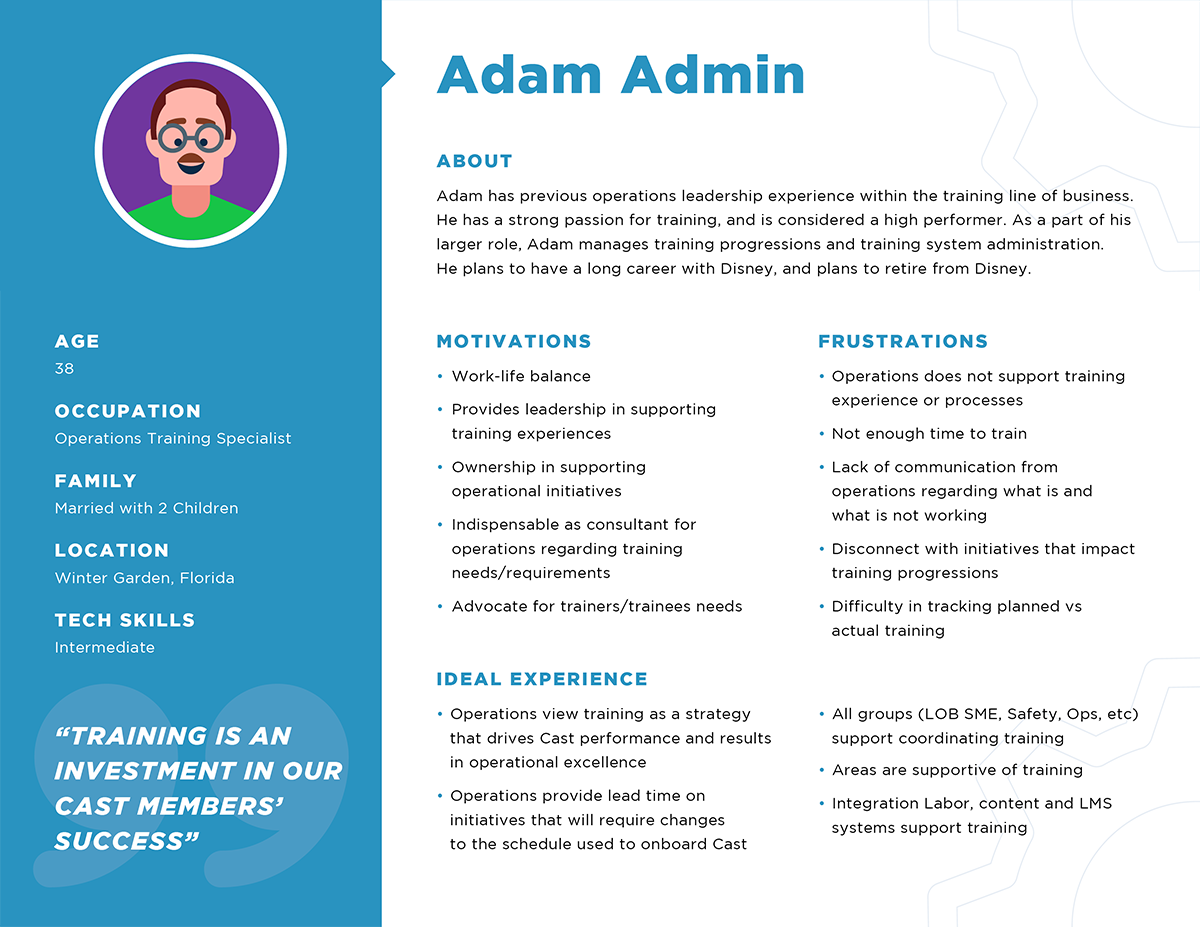
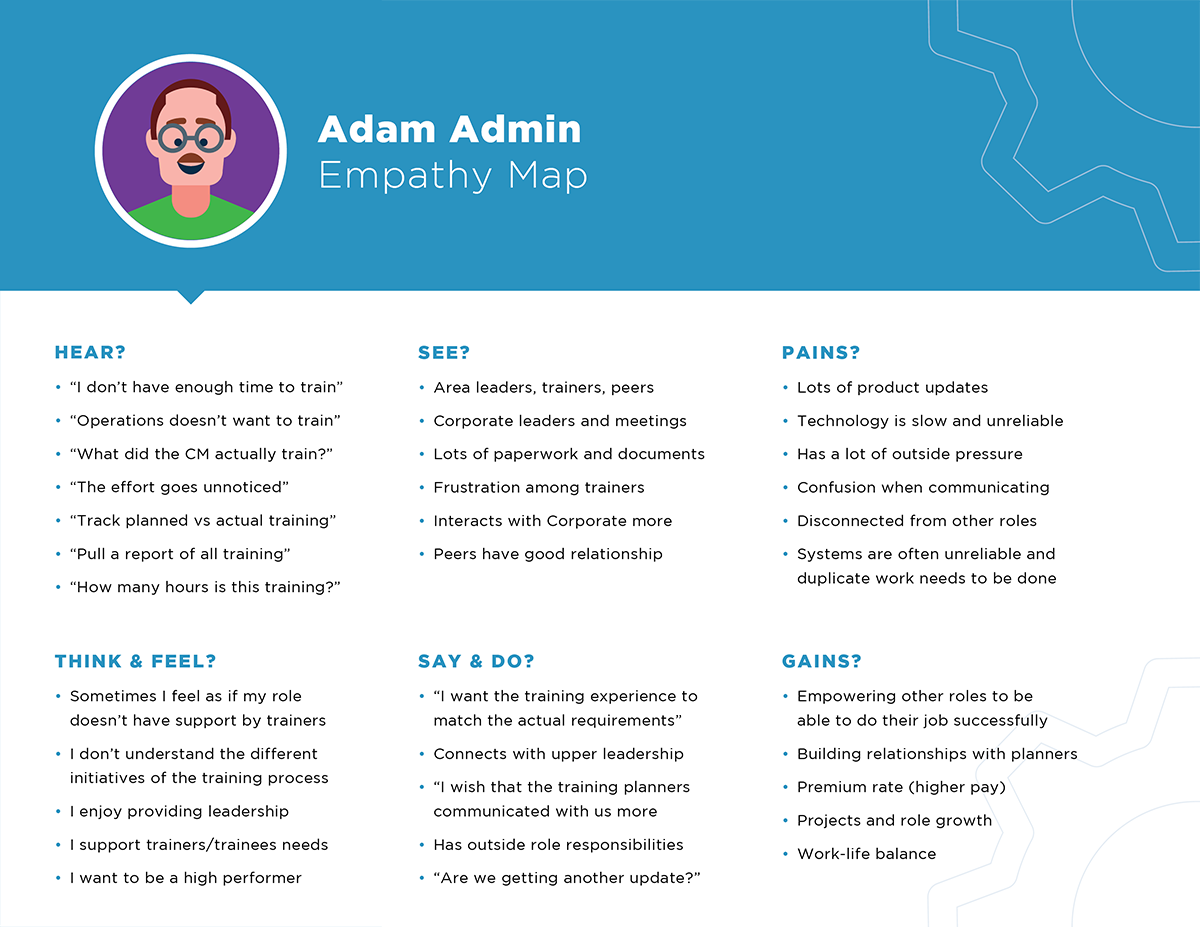

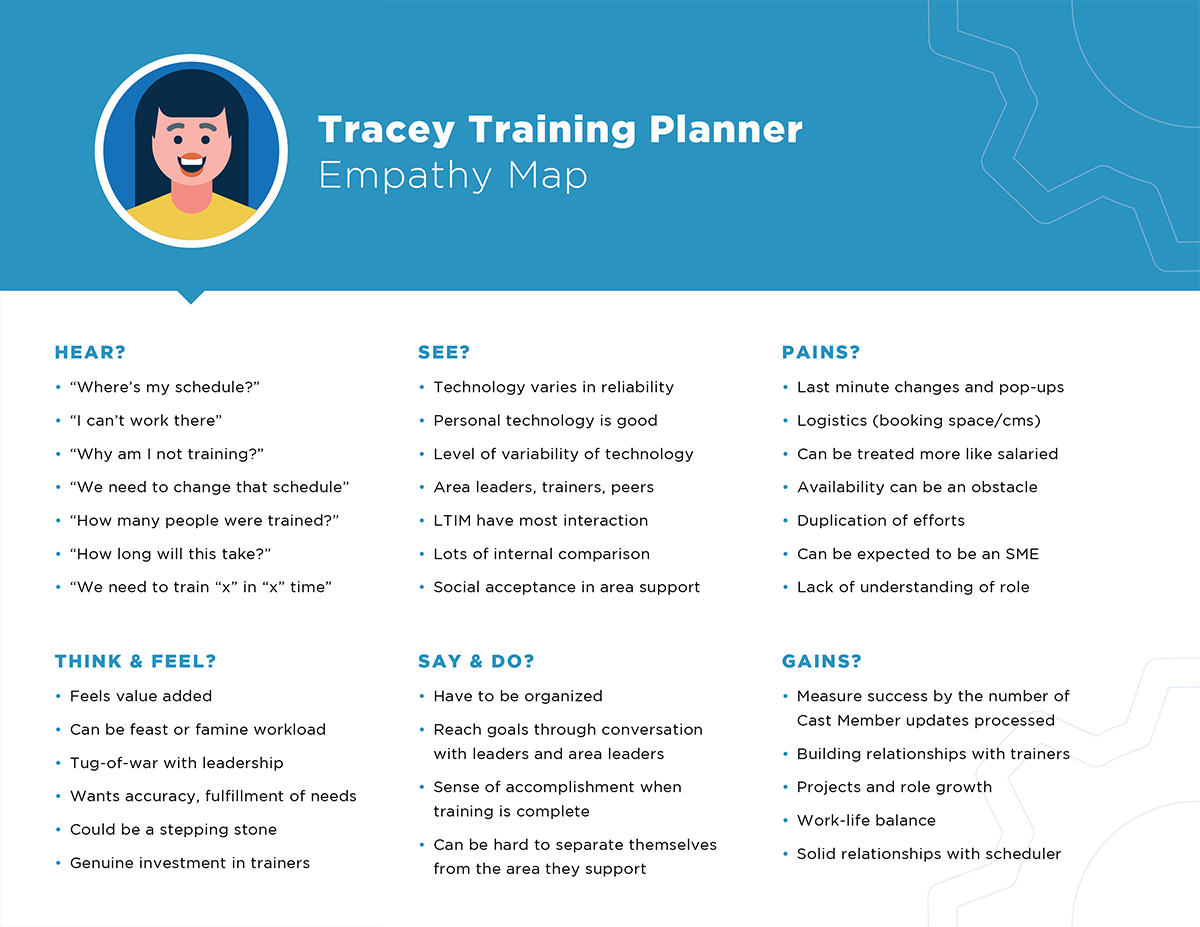
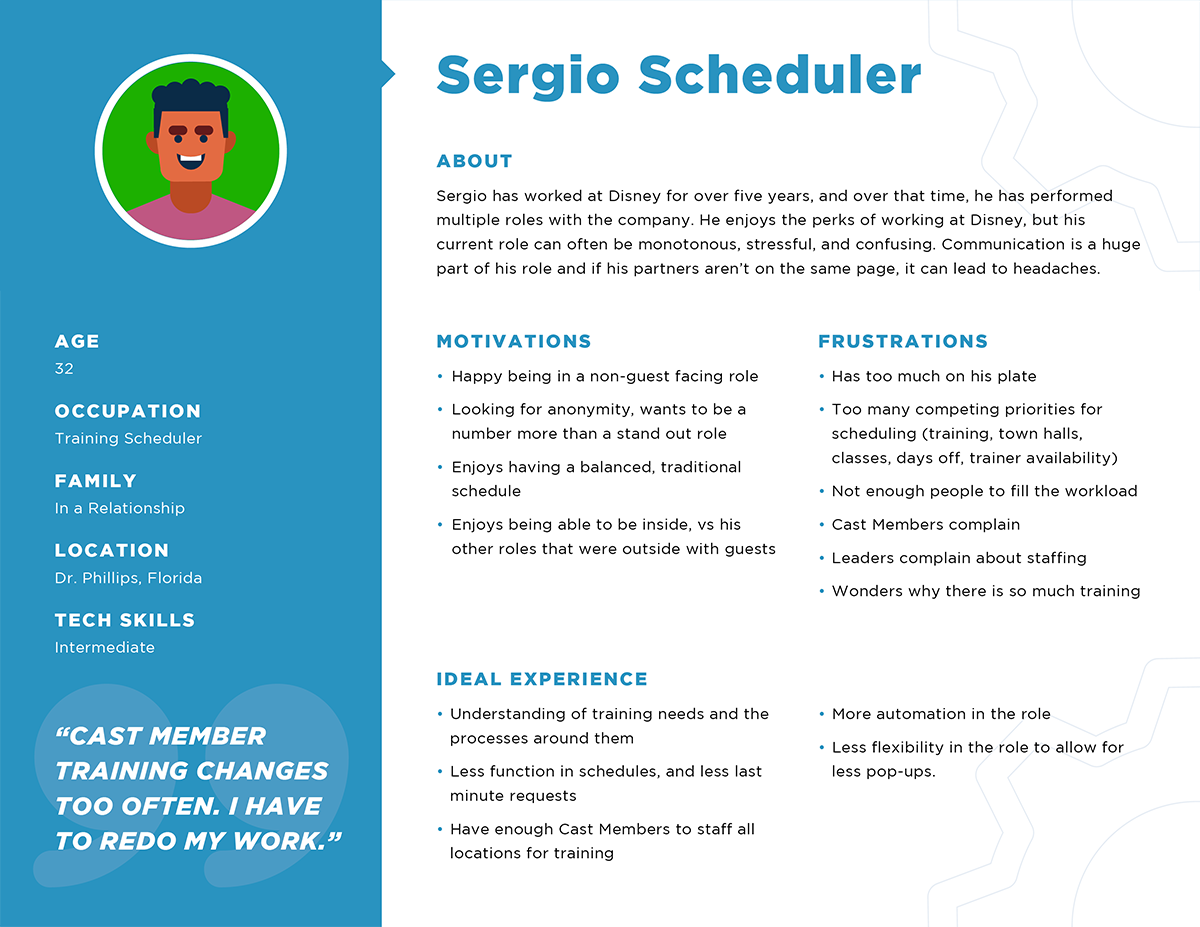
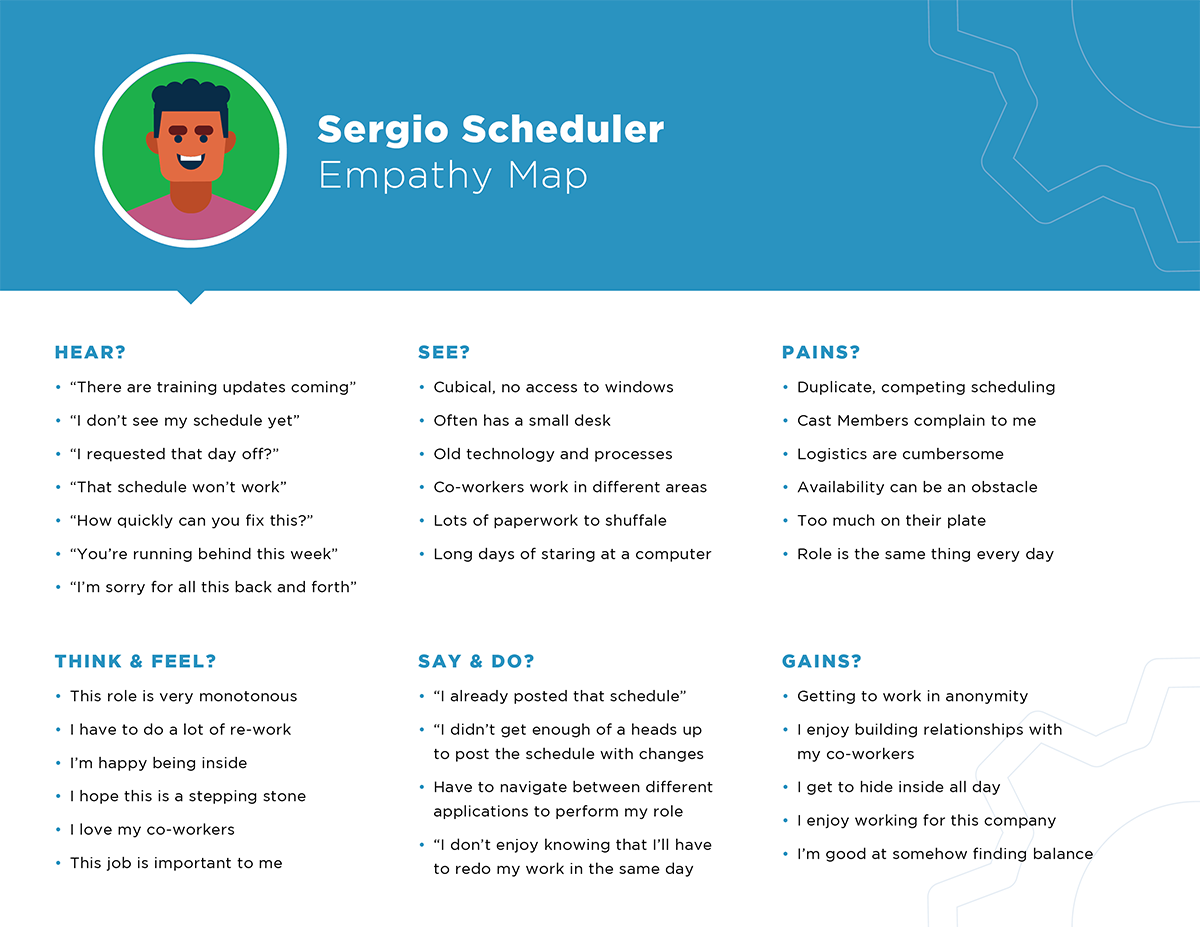


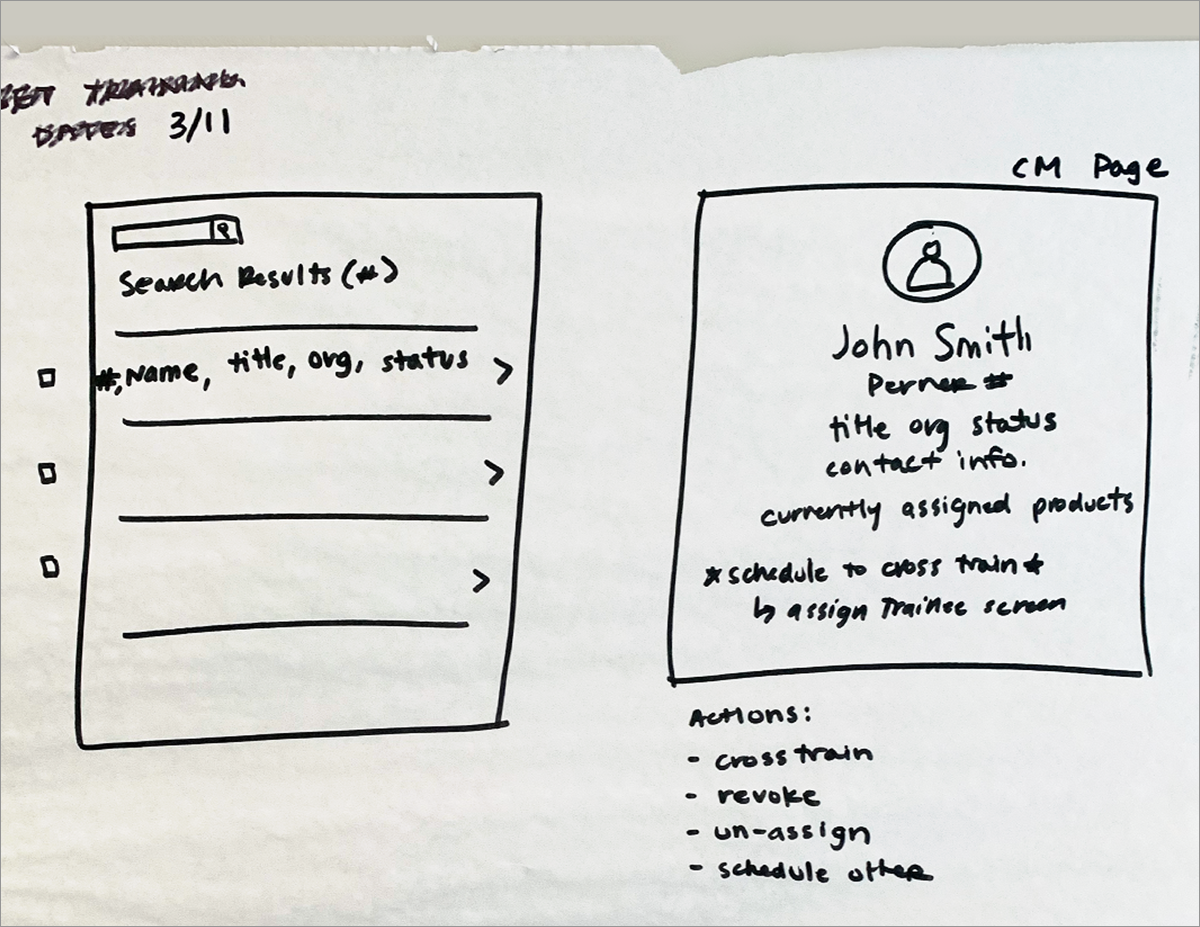
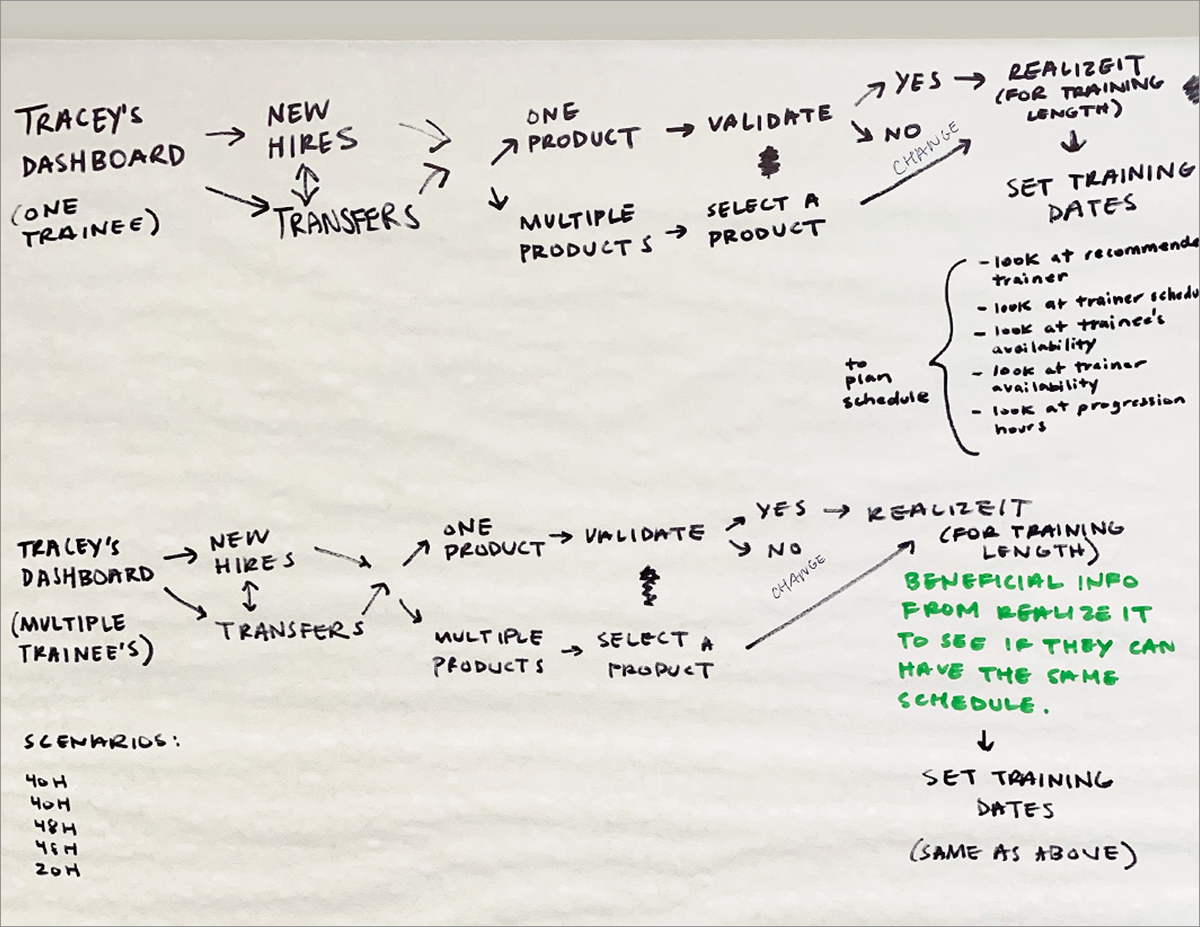
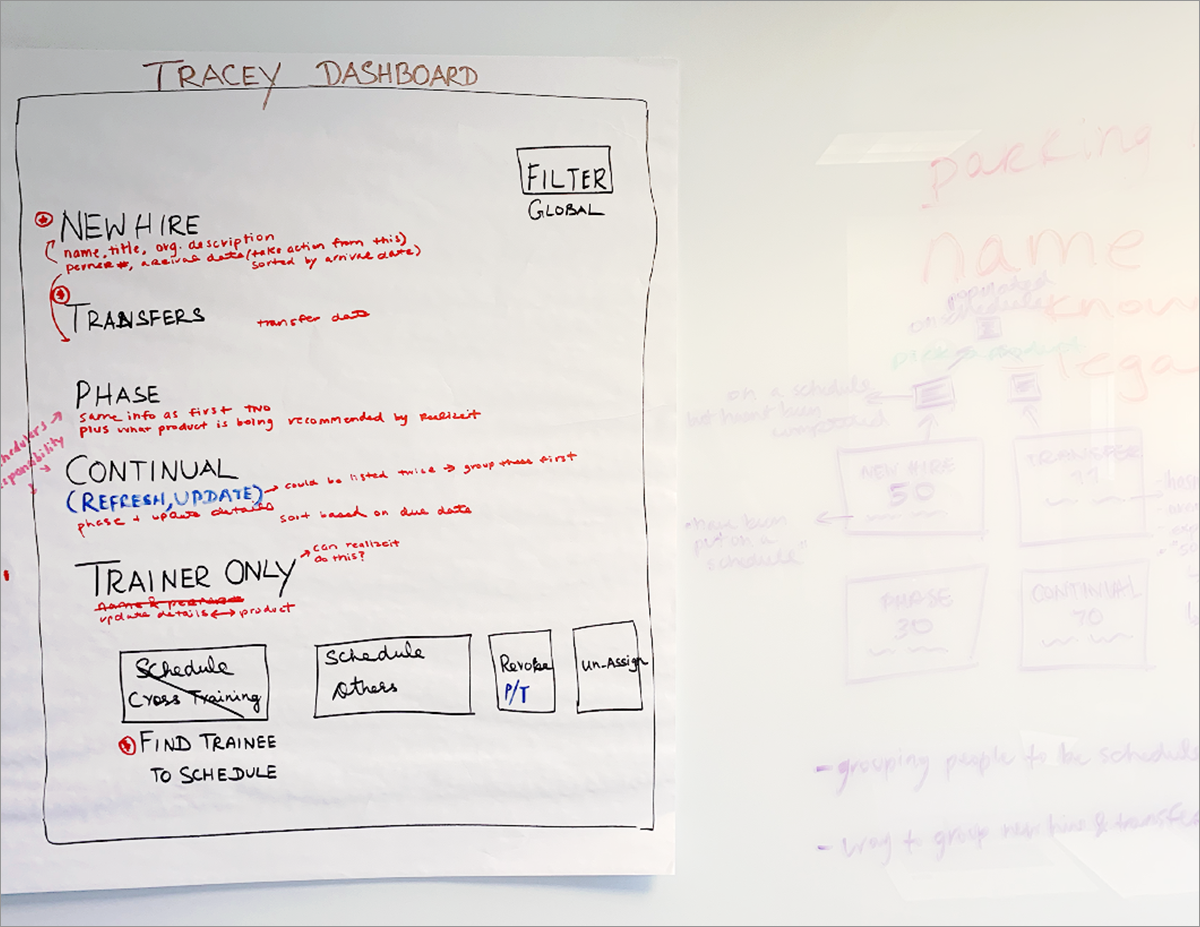
SKETCHBOARDING
I collaborated with the business team to sketch out user flows and rough wireframes.
With project requirements continually evolving, I initiated weekly sketchboarding sessions to capture ideas and actively guide user flow decisions. This dynamic approach allowed us to explore design possibilities rapidly while keeping the business and engineering teams aligned on user stories and project goals.
WIREFRAMES
I created multiple wireframe variations for each screen to foster feedback and discussions with business leadership and the internal UX team.
At Disney, the internal UX team had developed an extensive design system called Kingswell, which included dozens of controls, components, and design patterns. This robust system made the iterative wireframing process much more efficient, enabling rapid exploration of design ideas without starting from scratch each time. Leveraging Kingswell allowed me to present more polished and cohesive design options to the business and engineering teams, which greatly facilitated clearer communication and helped solidify user stories and project requirements. Throughout this process, I worked closely with the internal UX team to gather valuable feedback, address any questions, and continuously refine my designs.
USER TESTING
Being able to test my simulations directly with users proved crucial—it provided invaluable insights that shaped the design and ensured the final product truly met their needs.
After coordinating with the business team, I conducted prototype testing with five prospective users to capture their initial reactions and impressions. I loaded the simulation onto their computers, and observed as they independently navigated the interface. To encourage open feedback, I asked questions such as, “What do you see on the screen, and what does it mean to you?” and “If you wanted to perform this action, how would you go about it?” This approach invited Cast Members to think aloud and lead the conversation, while I carefully observed and took detailed notes. Afterwards, I collaborated with the business team to analyze the feedback and prioritize which changes to implement. This iterative testing cycle was instrumental in refining the application to better align with user needs and expectations.
Notable insights from user testing included:
“What if I need to assign training to a Cast Member who hasn’t been onboarded yet?” We responded by adding a feature that identifies trainees yet to be onboarded, enabling their training assignments without delay.
“How can I create a training experience that isn’t tied to a specific product?” To address this, we introduced greater flexibility, allowing training experiences to be created without requiring a product association upfront.
“Pretty darn cool!” Moments like these were especially rewarding, confirming that our users not only found the application effective but genuinely enjoyed the experience.
USER FLOW 1
Assigning a training experience product to a new hire Cast Member.
The goal of this user flow was to empower our persona, Tracey, to efficiently assign training experiences to one or more trainees. On her dashboard, I designed three primary cards highlighting her core responsibilities: assigning training, scheduling trainees, and monitoring who has already been scheduled. It was crucial to clearly present the number of users requiring attention in each category—for example, the “Assign” card prominently displays the eight trainees awaiting assignments. By clicking the ‘Assign Products’ button, Tracey is seamlessly directed to her list of trainees ready for training assignments.
From this screen, Tracey can easily sort and filter her list to group trainees who need the same training product. When she selects her first checkbox, a blue ribbon appears, clearly highlighting the chosen trainees for batch assignment. By clicking the “Assign” link within that ribbon, she opens the “Assign Product” modal, where she can quickly choose from recommended products tailored to her business location—or select an alternative product if desired. Finally, by clicking the primary “Assign Product” button, Tracey submits the assignment and receives an immediate success message confirming the products have been assigned.
USER FLOW 2
Creating and scheduling a training group for the "Mad Tea Party" attraction.
The most extensive and complex flow in the application empowered over 500 Cast Members to create training groups and plan their trainees in a way that best suited their individual workflows. Although the business team opted against enforcing a strict, uniform user flow, I established key guiding principles to bring structure where possible. Every user starts on their dashboard, where the “Plan” card prominently displays the number of trainees awaiting scheduling. From there, Cast Members can select a specific training product to begin the planning process.
Once Tracey decides to continue with an existing plan or start fresh, she arrives at the calendar screen—designed for maximum flexibility. The interface separates shift cards at the top from the trainee and trainer lists below, allowing her to tailor the planning process exactly to her needs. Whether adding only trainees, assigning trainers to select shifts, or mixing and matching trainees while scheduling specific dates and times, this streamlined and adaptable system supports all those workflows seamlessly.
THE SOLUTION
Finally, our users won't need to open Microsoft Excel anymore.
Launched in February 2020 to coincide with the debut of Mickey and Minnie’s Runaway Railway, this application finally replaced the decades-old, Excel-based, paper-heavy process Cast Members had relied on. Featuring five distinct personas, over 30 screens, and more than 15 user flows, I crafted a modern, efficient, and intuitive experience designed to serve users for years to come. I’m thrilled to see this application continue to grow and make a lasting impact!
WHAT I LEARNED
It's imperative to keep the users top of mind, at all times.
With few chances to engage directly with users, it was tempting to rely solely on the business team’s perspective to represent them. However, I quickly recognized the critical importance of consistently championing the user’s needs throughout the entire process. Equally essential was maintaining clear communication with the engineering team about any changes to user stories, ensuring all teams stayed aligned. As my first full-scale user experience project, this journey ignited my passion for UX and gave me a profound sense of fulfillment, knowing I was making a meaningful difference in people’s everyday lives.
ONE MORE THING...
I had the opportunity to completely redesign the Welcome Itinerary sent to new hires, transforming it into a powerful first touchpoint that sets the tone for their entire onboarding journey.
The Welcome Itinerary is the first onboarding document new Cast Members receive, outlining their role, schedule, costuming guidelines, and more. As shown below, the original itinerary lacked brand alignment and failed to make a compelling first impression. I took the initiative to completely redesign it—creating a more engaging, immersive, and, most importantly, mobile-friendly experience. While reimagining the training planning process was rewarding on its own, knowing that my work would positively impact tens of thousands of Cast Members during this crucial onboarding phase made the project especially meaningful and fulfilling.
